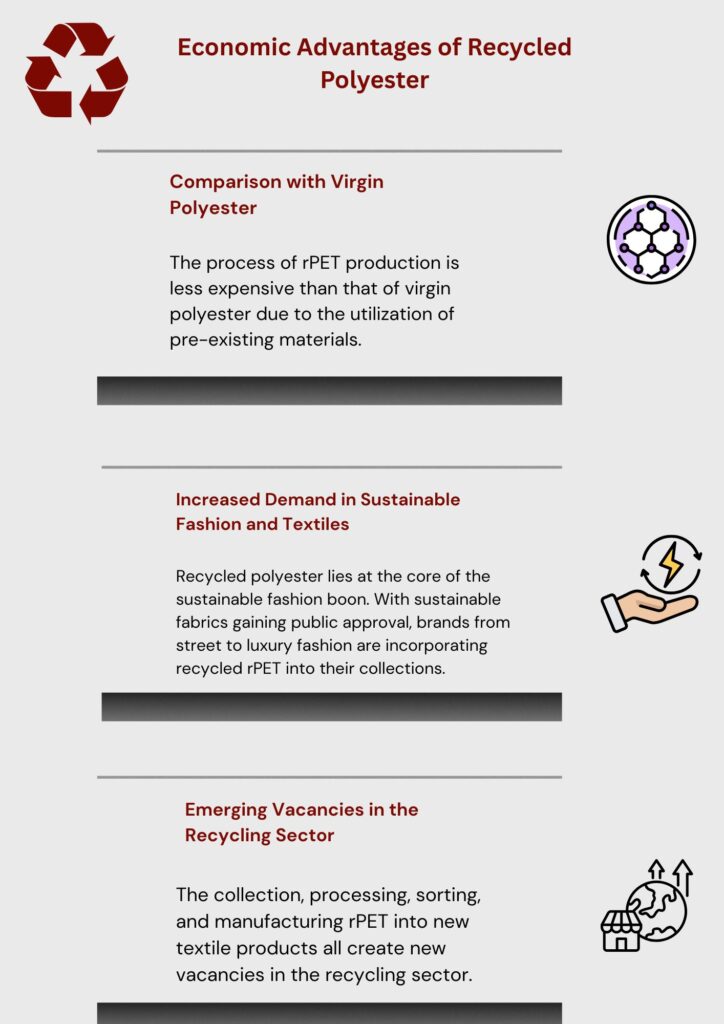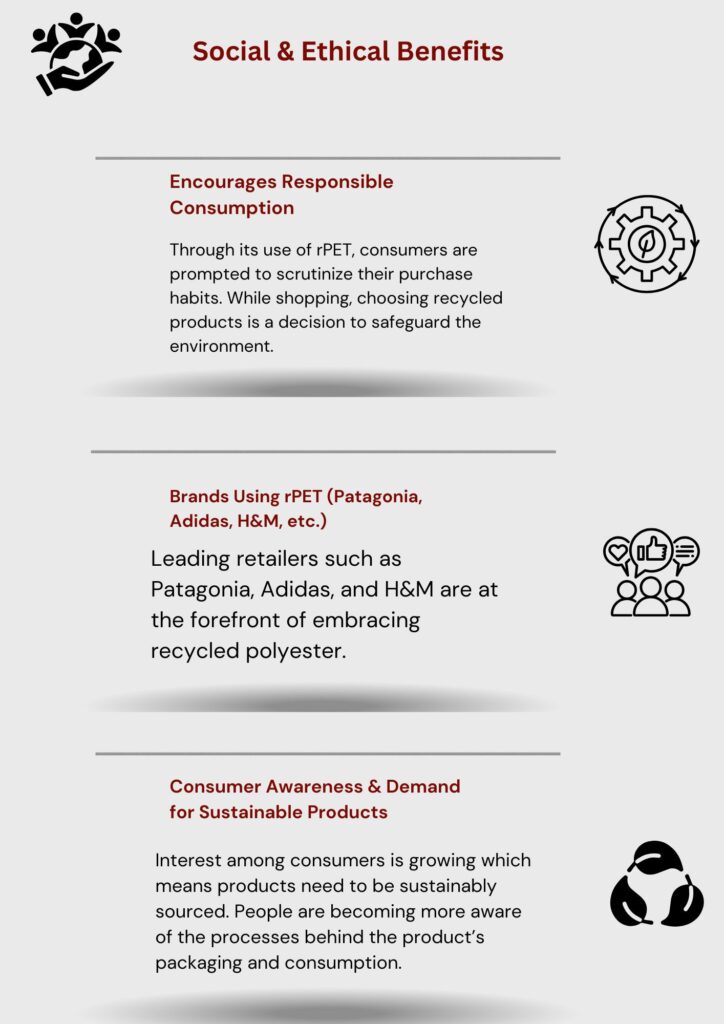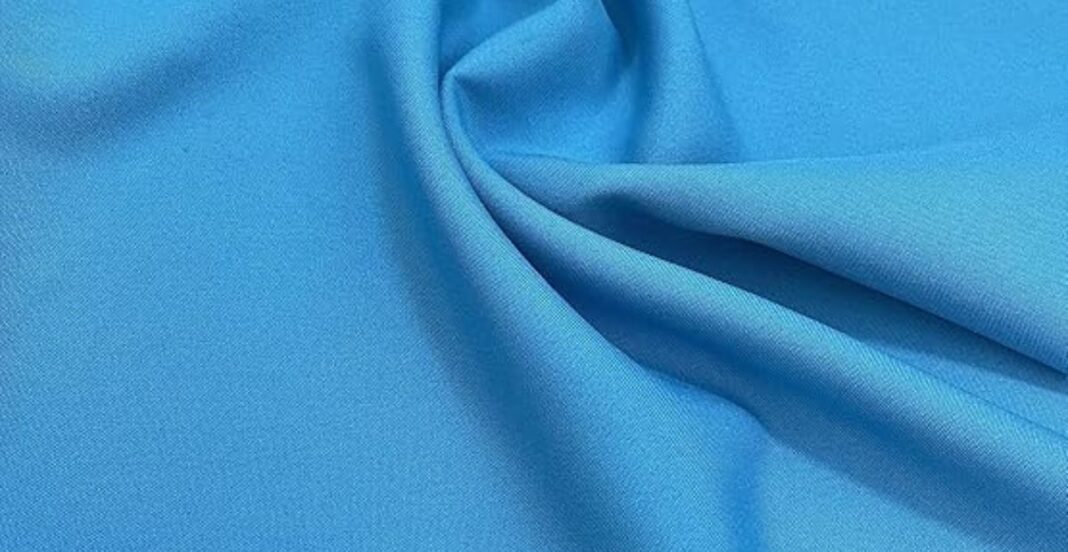Introduction
Recycled polyester or rPET is revolutionizing the textile industry by giving plastic waste a new life as a durable fabric. With increasing demand from both consumers and businesses, rPET is quickly becoming the go to materials of choice. It’s innovative fibers marrying sustainability with performance makes it ideal in today’s world, and a forward-thinking world.Benefits of recycled polyester
In the following sections we’ll look into what further details are available on recycled polyester and its production while comparing it with traditional polyester.
What is Recycled Polyester?
Recycled polyester is classified as a fabric due to its composition which is derived from plastic, specifically used PET bottles. Instead of contributing to pollution by creating new polyester from oil, manufacturers can collect waste plastic and turn them into fibers which then spun into yarn and woven or knitted into fabric. This process is beneficial by reducing waste, while simultaneously creating materials with equivalent performance to virgin polyester.
Activewear, jackets, furniture, and accessories all commonly use recycled polyester. The emerging trends appeal to environmental concerns and sustainability, alongside its versitility make it an attractive option.
How is it Made? (Mechanical vs. Chemical Recycling)
There are two main mekanis of producing rPET: mechanical recycling and chemical recycling. The former is traditional and involves cleaning, shredding, melting plastic, and re-spinning it into fibers. It is efficient in energy use, but over time, the fiber quality may decrease.
Chemical recycling, on the other hand, is the process that breaks down plastics into their base molecules. This process yields high purity rPET, essentially equivelent to virgin polyester. It is more costly to implement, but in the long run, it supports limitless recycling.
Both techniques offer diverse benefits, and further advancements in technology are still improving their effectiveness.
Comparison with Virgin Polyester
The raw material for producing virgin polyester is petroleum. Extracted fossil/inexhaustible fuel. Apart from this, their production uses a large amount of water, energy, and releases ghg gasses. On the other hand, recycled poyester sharply cuts these environmental burdens.
Both materials offer almost the same level of strength and flexibility, however, for environmentally minded folk out there, rPET is the clear choice. Going for rPET reduces the need aquired for fossil fuels and lowering plastic waste, hence performing better for a healthy environment.
Advantages for the Environment of Recycled Polyester
The rising acceptance of rPET is significantly attributed to its environmental advantages. In what follows, we will look into how recycled PET (rPET) proves beneficial for the environment.
Curtailment of Plastic Waste (Plastic Bottles that are disposed of)
Each year, a staggering volume of plastic bottles- tens of billions- composted, posing a significant threat to the environment. The process of recycling polyester takes out the space of used PET bottles from the waste stream. The bottles are collected, sanitized, then transformed into useful textiles. This prevents plastics that would have contributed towards pollution.
Actually, the recovery of one ton of rPET reduces more than seventy thousand plastic bottles. The brands and consumers both are stepping towards the reduction of pollution by opting for rPET.
Less Greenhouse Gases Emission (Fossil fueled powered plants produce more than necessary rPET)
The processes put into place to produce rPET polyester require approximately 59% less energy when compared to virgin polyester, in addition, there is a lowered water usage as well as emission of greenhouse gasses. In light of the energy intensive nature of the industry, rPET serves as a low impact alternative.
The lowered amount of fossil fuels used leads to a lowered a carbon emission, this becomes more important due to climate change. The quality reduction during rPET production is achievable without undermining the goal of sustainability
Decreases Dependency on Petroleum (Fossil Fuels)
Utilization of rPET mitigates the need for extracting and refining crude oil since it uses repurposed materials instead of petroleum – decreasing dependence on fossil fuels. While virgin polyester relies on petroleum, a limited and rPET does not depend on it.
Transitional steps need to be taken away from fossil fuel based fabrics, particularly with soaring oil prices. Recycled polyester enables a pathway toward more environmentally and ethically responsible actions in textile and apparel production.
Supports Circular Economy Principles
Recycled polyester supports the circular economy by integrating the linear model of “take-make-dispose” into a regenerative model where rPET advances reusing and renewing materials, thus making progress toward breaking the linear cycle.
Implementing sustainable approaches to lengthen the lifespan of materials alleviates the burden of extracting new raw materials and that embraces circular reasoning to close the loop. Circular systems such as rPET work toward greater sustainability in the fashion and textile industries.
Economic Advantages of Recycled Polyester

The economic advantages of recycled polyester, rPET, are remarkable. They start becoming clear when looking at the financial side of rPET in relation to the growing demand for sustainable goods.
Comparison with Virgin Polyester
The process of rPET production is less expensive than that of virgin polyester due to the utilization of pre-existing materials. While the initial investment for recycling systems may be high, they lead to considerable reductions in production costs over time.
The decreased availability of rPET prompts more businesses to invest in recycling technology, simplifying access to recycled materials. This strategy also serves to reduce overall manufacturing expenditure without impacting the quality of recycled materials.
Increased Demand in Sustainable Fashion and Textiles
Recycled polyester lies at the core of the sustainable fashion boon. With sustainable fabrics gaining public approval, brands from street to luxury fashion are incorporating recycled rPET into their collections.
The surge in demand seems to be propelling innovation while simultaneously increasing infrastructure. With expectations for significant growth over the next few years, the rPET market value is clearly expanding.
Emerging Vacancies in the Recycling Sector
The collection, processing, sorting, and manufacturing rPET into new textile products all create new vacancies in the recycling sector. Expanding recycling centers presents opportunities for both skilled and unskilled laborers.
Recycling rPET creates new opportunities for investment which in turn supports green employment and the local economies. These new green jobs help build a green supply chain that is beneficial for both humans and the Earth.
Benefits of Performance and Quality
Apart from sustainability, the use of rPET is impressive in performance as well as quality. It is in no way less than virgin polyester in terms of durability and improves functionality in many other products.
Recycled polyester fabrics are as strong, flexible, and long lasting as virgin polyester. It is as good as fabrics like clothing, does not lose its shape or color over time. It is also used in backpacks and upholstery.
Durable materials are essential for products that are designed with longevity in mind. Recycled polyester offers durability while also being strong blended with other fibers like cotton or spandex.
Just Like Virgin Polyester
Just Like Virgin PolyesterMoisture-wicking is one of the recycled polyester technologies stripped off from virgin polyester. rPET is light-weighted, quick to dry, and excellent in moisture-wicking. This makes it appealing for sporting and outdoor attire.
Like virgin polyester, it helps regulate temperature around the body while exercising and is breathable. rPET fabric is preferred among consumers who want comfort, function, and style.
Applied In Athletic Apparel, Outdoor Gear, Home Furnishings
The strength and comfort features of recycled polyester allow use across different sectors. It is used in athletic apparel, jackets, backpacks, and even sleeping bags. The material is also found in curtains and cushions.
Its ability to resist stretching, shrinking, and mildew makes it even more attractive. As more people become informed, more companies start using rPET for regular and specialized products.
Social & Ethical Benefits

The recycling of polyester has positive social effects as well. It assists in responsible consumer production while simultaneously changing the way people think.
Encourages Responsible Consumption
Through its use of rPET, consumers are prompted to scrutinize their purchase habits. While shopping, choosing recycled products is a decision to safeguard the environment.
Consumers making responsible purchasing choices leads to improvement in the quality of items produced by manufacturers while also combating the adverse effects of fast fashion. Campaigns about rPET education help shoppers think before they buy and save resources.
Brands Using rPET (Patagonia, Adidas, H&M, etc.)
Leading retailers such as Patagonia, Adidas, and H&M are at the forefront of embracing recycled polyester. Adidas has produced millions of ocean plastic shoes while Patagonia recycles old jackets and fleeces.
These businesses demonstrate that scaling is achievable. These brands have other companies invest in the production of recycled materials.
Consumer Awareness & Demand for Sustainable Products
Interest among consumers is growing which means products need to be sustainably sourced. People are becoming more aware of the processes behind the product’s packaging and consumption. This demand is met by rPET since it has ample sustainable and responsible alternatives.
As this trend grows, there’s a switch to brands that prioritize these issues. People supporting rPET also helps protect the rPET’s core ideology.
Challenges & Misconceptions
Recycled polyester has its own obstacles to overcome, but the benefits far outweigh them.
Concerns About Microplastic Shedding
Just like every other synthetic material, rPET can shed microplastics during washing. These microfibers are captured by marine life, which are then injected into the ecosystem. On the other hand, shedding is minimized with the use of washing bags and filters.
To aid in this issue, consumers can take larger steps in aiding the environmental impact by striving to make smaller changes.
Limitations on Recycling (Closed Playing vs. Open Playing Systems)
Not all forms of recycling are flawless. Downcycling can occur with certain fabrics made out of recycled rPET because they cannot be further recycled. Closed loop systems aim to retain materials that are continuously salvageable.
There is a need for advancement in technology and infrastructure for large scale circular frameworks. Single use plastics or virgin polyesters will still be a better choice in comparison to rPET for now.
Risks of Greenwashing ( How to Spot a Sustainable Brand)
Without taking real actions, certain brands claim to be sustainable. Greenwashing is the term that describes this act. Look for reliable certifications such as global recycled standard or oeko-tex to avoid greenwashing.
Brands are able to make false advertisement claims and data, so doing thorough investigative work or brands should have their claims backed up with solid analytics. True eco friendly companies will stand out with their real claims
Innovations in Recycling Polyester
Policies and public support signifying a shift towards greener solutions absolutely boost polishing recyclables.
Post-consumer Waste Innovations
Recent strides toward advanced recycling technology has made rPET more efficient. Further improvement through enzymatic and molecular recycling could soon enforce a closed loop cycle for polyester.
Permanent defended loops for high quality rPET fabric provides lower carbon emissions through less waste, producing better and more durable products while recycling endless fabrics.
Government Policies & Support
Laws have been put in place worldwide that reduce plastic waste while promoting recycling through cutting edge incentives and subsidies. These policies ensure a greener production to reduce carbon emissions.
Within the next coming months, brands may be mandated to utilise rPET in their products enforcing stronger policies, which as we know, greatly drive growth towards sustainable options.
How patrons can back the clothing brand adoption
Patrons instill remarkable change by endorsing brands that actively use repeayed polyester. Purchases alongside motivational practices, including maternity leave from fast fashion brands supports the cause.
Reviewing tags and celebrating fast fashion’s end will collectively ease the fight on emissions. With intention, substantial recompenses in fashion can follow.
Conclusion
Performance areas are enhanced alongside the environmental, economic and social impact within recycled polyester.
Transformed from waste, products improved align waste processes with modern demand.
Each buying decision does have significance. Choosing rPET demonstrates positive support towards sustainability, innovation, and ethical business practices, so keep pushing for eco-friendly option and transparent alternatives.
Today, you can: purchase recycled products, recycle in a responsible manner, and join the movement for change.
FAQs
Recycled polyester rPET is a type of textile created from reclaimed plastics, specifically PET bottles. The plastic is purified, heated, and eventually spun into polyester fibers. Although rPET is processed its impact is lesser when compared to virgin polyester.
Some top advantages include reduced plastic waste and carbon emissions, less water and energy consumption, lower reliance on fossil fuels, and bolstered circular economy. All of these are economically beneficial to many brands.
Recycled polyester greatly assists in reducing plastic dump and disposal in oceans and landfills. Production is still more environmental friendly as compared to virgin polyester as it uses 59% less energy and emission of greenhouse gases is also substantially lower.
No, rPET maintains the same strength, durability, and performance as virgin polyester. Because of its durability, rPET is ideal for use in activewear, outdoor clothing, and home textiles.


